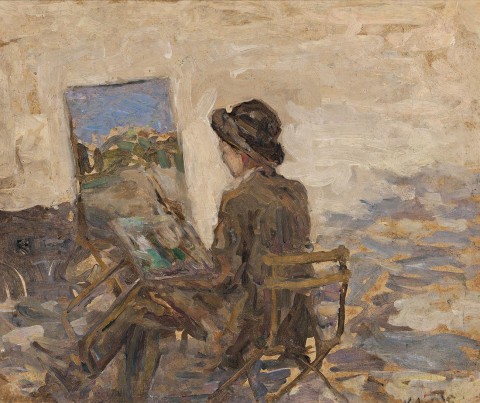ARTIST AND EASEL, LUXEMBOURG GARDENS, c.1910 – 14
KATE O'CONNOR
oil on board
44.5 x 54.5 cm
signed with initials lower right: KL O’C
signed verso: KL O’Connor
signed on partial label verso: … O’Connor
Osborne Art Gallery, Adelaide
Private collection
Christie’s, Melbourne (as ‘Portrait of the artist at her easel’)
Private collection, Melbourne, acquired from the above in November 1995
51e Salon de l’Union des Femmes Peintres et Sculpteurs, Paris, February 1935 (label attached verso)
Exhibition of Paintings by Kathleen O’Connor, Osborne Art Gallery, Adelaide, 28 April – 11 May 1965, cat. 18 (as ‘Artist Sketching, Luxemburg [sic.] Gardens’)
‘Kathleen O’Connor fixes the present almost at the moment of it becoming the past: movement is arrested, as if, by this trick, time might be stopped … The Luxembourg paintings … have a haunting, Proustian quality. They are ‘remembrances of things past’. Even as they were being painted in their own distant world, these paintings were essentially ‘recollections’; emotion caught in instants of tranquility and of insight’.1
Within the extended series of images that Kate O’Connor painted in the Luxembourg Gardens are occasional ‘snapshots’ of fellow artists engaged in similar endeavours, such as Two figures, Luxembourg Gardens, c.1910 – 14 (University of Western Australia, Perth). There is no implied commentary in these works; rather, they represent a simple record of focused observation, indicating that to her at least, artists formed part of the necessary and everyday fabric of life, a view in direct opposition to her former experience within the stifling etiquette of Perth society.
Given that it is painted on board, Artist and Easel, Luxembourg Gardens, would likely have been part of O’Connor’s second sequence of Gardens paintings created immediately after World War One and, through the inclusion of the subject’s own attempts at the easel, provides a distinctive contrast with many of its painterly companions. For the greater part, O’Connor utilised muted tones of beige, caramel and stone, with only occasional, though relatively subdued, flashes of colour. In Artist and easel, Luxembourg Gardens, however, the depicted artist has looked out – not inwards like O’Connor – and the burst of blue sky and verdant greens punctuate the picture plane. It also highlights that O’Connor’s choice of otherwise muted tones was a deliberate tactic, and through this, an inevitable sense of melancholy and wistfulness permeates these views.
1. Hutchings, P. A. E., and Lewis, J., Kathleen O’Connor: artist in exile, Fremantle Arts Centre Press, Western Australia, 1987, pp. 207, 211
ANDREW GAYNOR
